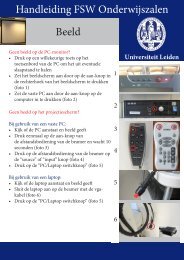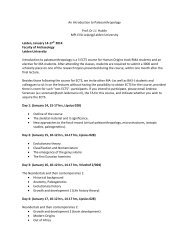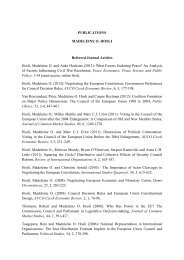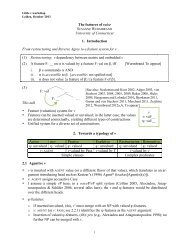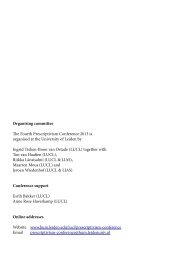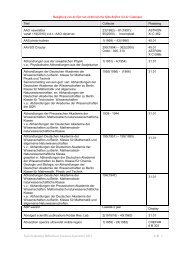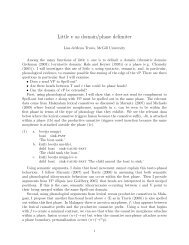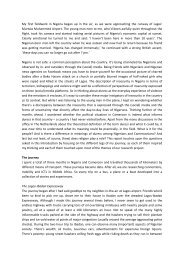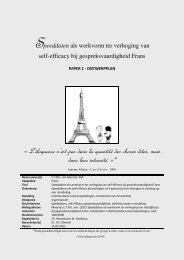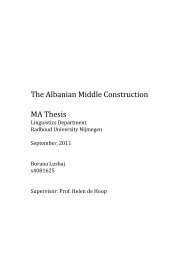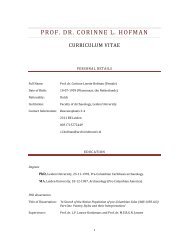Sandhya Sundaresan
Sandhya Sundaresan
Sandhya Sundaresan
Create successful ePaper yourself
Turn your PDF publications into a flip-book with our unique Google optimized e-Paper software.
In support of an articulated v layer:<br />
insights from Tamil<br />
Little v Workshop, University of Leiden, October 25, 2013<br />
<strong>Sandhya</strong> <strong>Sundaresan</strong>, Universität Leipzig<br />
sandhya.sundaresan@uni-leipzig.de<br />
☞ The goal of this talk is to argue, based on evidence from the Dravidian language<br />
Tamil, that the syntax and semantics of transitivity, ‘get’-like middles, and passives is<br />
distributed across three distinct heads.<br />
☞ These heads are contiguous and have the following rigid ordering: Transitivity <<br />
‘get’ < Passive.<br />
☞ As such, it makes sense to talk about an articulated v layer or domain – much along the<br />
lines of the articulated C layer/domain proposed within the cartographic framework<br />
(Rizzi, 1997; Cinque, 1999) – rather than a single v head.<br />
Tamil is a highly inflected agglutinative language:<br />
• The verbal form consists of the verb root + a sequence of functional morphemes.<br />
• These functional morphemes have a rigid relative ordering, thus serve as a window into<br />
the underlying structure above the verb root, in the region traditionally labelled vP.<br />
Below, I will consider three types of marking, all of which occur between the verbal root/stem<br />
and morphemes that realize a higher portion of the structure, such as tense and agreement<br />
markers:<br />
☞ Transitivity marking<br />
☞ Middle marking (with a get-type semantics)<br />
☞ Passive marking<br />
1 Transitivity marking in Tamil<br />
☞ Transitivity distinctions in Tamil are typically marked by a systematic (phonological)<br />
voicing distinction – either on the coda of the stem-final syllable or on the aspectual<br />
marking directly following the stem.<br />
Thus, in (1) below,the voiced form of ‘break’ oãæ-nÃ- is interpreted as unaccusative whereas<br />
its voiceless variant oãæ-čč in (2) must be used transitively:<br />
(1) Unaccusative:<br />
1
<strong>Sandhya</strong> <strong>Sundaresan</strong><br />
In support of an articulated v layer<br />
Paanæ oãæ-nÃ-adŭ/*oãæ-čč-adŭ.<br />
Pot[nom] break-intr.asp-3nsg/*break-tr.asp-3nsg<br />
“The pot broke.”<br />
(2) Transitive:<br />
Sri paanæ-jæ oãæ-čč-aan/*oãæ-nÃ-aan.<br />
Sri[nom] pot-acc break-tr.asp-3msg/*break-intr.asp-3msg<br />
“Sri broke the pot.”<br />
Further examples of this type of transitivity alternation are provided in Table 1 below:<br />
Verbal root Unaccusative stem Transitive stem<br />
oãæ (break) oãæ-nÃ- oãæ-ččsurugŭ<br />
(shrink) suru-ŋg- suru-kkvaíar<br />
(grow) vaíar-nd vaíar-ttveãi<br />
(burst) veãi-nÃ- veãi-ččkiri<br />
(tear) kiri-nÃ- kiri-ččmaãi<br />
(fold) maãi-nÃ- maãi-čč-<br />
Table 1: Transitive and unaccusative verbal stems<br />
• Given that this voicing alternation directly tracks alternations in transitivity, it seems<br />
reasonable to propose that it encodes a position related to the introduction of the<br />
external argument – very much like the Voice head in (Kratzer, 1996).<br />
• However, I’ll shortly be arguing that there are other morphemes in the verbal complex<br />
that appear to perform functions that one might have associated with Voice.<br />
• To avoid confusion with different potential meanings of “Voice”, I’ll thus label this<br />
head “Trans” and be specific about its function, which is to introduce the external<br />
argument of the verb in its specifier and associate it with a specific θ-role.<br />
I envision a transitive verbal structure like that in (3a), familiar again from the Kratzer<br />
(1996) structure for the introduction of an external argument, and an intransitive structure<br />
like that in (3b):<br />
(3) a. TransP<br />
b. VP<br />
DP<br />
Raman<br />
VP<br />
Trans’<br />
Trans<br />
V<br />
oãæ<br />
DP<br />
pot<br />
V<br />
oãæ<br />
DP<br />
pot<br />
2
Little v Workshop: Leiden October 25, 2013<br />
• The intransitive variant in (3b) is seen as basic, with the verbal structure being voiced<br />
by default.<br />
• In (3a), the presence of the Trans head will, either directly or indirectly, result in the<br />
devoicing of the phonological material in this region (be it the stem-final syllable or<br />
the aspectual morpheme directly following it).<br />
Note, incidentally, that there are different potential strategies to deal with the idea that<br />
transivity alternations has the appearance of a morphophonological process – as briefly<br />
described below – and I will not concern myself with the details here:<br />
(i) via DM-style readjustment rules (Halle and Marantz, 1993)<br />
(ii) Nanosyntax-style spanning/non-terminal SpellOut (Ramchand, 2008; Caha, 2009)<br />
(iii) the insertion of an abstract piece of morphophonology that in turn effects a phonological<br />
process (as recently proposed in Bye and Svenonius, 2012).<br />
2 Passive marking in Tamil<br />
Now consider the passive structure below:<br />
(4) Paanæ (Sri-aal) oãæ-kkæ-paú-ú-adŭ/*oãæ-jæ-pa-ú-ú-adŭ.<br />
Pot[nom] (Sri-instr) break-tr-pass-pst-3nsg/*break-intr-pass-pst-3nsg<br />
“The pot was broken (by Sri).”<br />
The structure in (4) is instructive in several regards:<br />
• (4) shows that the passive has to be built on the transitive variant of the verb (seen in<br />
(2)).<br />
• It thus supports the view (Embick, 2004, among others) that passives are more “agentive”<br />
than unaccusatives in some sense.<br />
• Crucially furthermore, (4) shows that the passive applies to a verbal structure that has<br />
already had the phonological (de-)voicing process apply to it.<br />
• This is most elegantly captured by proposing, according to the Mirror Principle, that<br />
the head that the passive marker paã- spells out (call it Pass) is above Trans.<br />
This results is further articulation in the structural zone traditionally associated with a single<br />
head (namely v), as illustrated below: 1<br />
1 I have drawn a specifier position for Trans and assume that this will either be filled by an empty<br />
operator controlled by the instrumental-marked agent (the equivalent of a ‘by’-phrase) or will be filled by<br />
the instrumental-marked agent directly. Of course, Embick (2004) proposes that the TransP (VoiceP in his<br />
terminology) is specifierless to begin with – I later present some evidence that might contradict this idea,<br />
however – but don’t take a firm stance on this position for now.<br />
3
<strong>Sandhya</strong> <strong>Sundaresan</strong><br />
In support of an articulated v layer<br />
(5) PassP<br />
TransP<br />
Pass<br />
DP<br />
Trans’<br />
paã-<br />
VP<br />
Trans<br />
V<br />
oãæ<br />
DP<br />
pot<br />
☞ The data from passives thus argues against the idea that there is a single head (e.g.<br />
Voice) which is responsible for the unaccusative-transitive alternation as well as the<br />
active-passive one.<br />
☞ Rather, the evidence suggests that these alternations are encoded on two distinct<br />
heads, with the head responsible for encoding passivity being higher than that which<br />
introduces the external argument.<br />
3 Introducing the koí morpheme<br />
There is another type of morpheme which can occur in the Tamil verbal sequence:<br />
☞ This is a morpheme koí which, I will argue, has a middle-like semantics.<br />
☞ The distribution, syntax and semantics of this morpheme are also instructive in understanding<br />
the shape of the v domain in Tamil.<br />
In the typical case, co-argument reflexivity in Dravidian is only possible under the presence<br />
of a morpheme koí suffixed onto the verbal stem, as (6) illustrates:<br />
(6) Sri i tann-æ {i,∗j} aãi-ččŭ-kko-ïã-aan/*aãi-čč-aan.<br />
Sri[nom] anaph-acc hit-tr-koí-pst-3msg/*hit-tr.pst-3msg<br />
“Sri i hit himself {i,∗j} .”<br />
koí also marks unaccusatives, as shown below:<br />
(7) Paanæ oãæ-nÃŭ-ko-ïã-adŭ/*oãæ-ččŭ-ko-ïã-adŭ.<br />
Pot[nom] break-intr-koí-pst-3nsg/*break-tr-koí-pst-3nsg<br />
“The pot got broken.” (rough translation)<br />
• The distribution of koí seems to support popular analyses (see e.g. Alexiadou, Anagnostopoulou,<br />
and Everaert, 2004, for different proposals in this spirit) according to<br />
which reflexives and unaccusatives share an identical structural subcomponent, based<br />
on the observation that they are often identically marked crosslinguistically.<br />
4
Little v Workshop: Leiden October 25, 2013<br />
• I.e. it seems to bolster the idea that reflexivity is (always) a species of voice phenomenon.<br />
• Based on very similar data, Lidz (2001, and subsequent), in fact, proposes that koí in<br />
the closely related Dravidian language Kannada spells out a specifierless Voice head<br />
in unaccusative and reflexive structures, much along the lines of Embick (2004) for<br />
non-active morphology in Greek.<br />
However, closer inspection reveals that koí (at least in Tamil) realizes a head distinct from<br />
Kratzerian Voice (which I’ve been calling Trans):<br />
I. koí-suffixation on unaccusatives is fully optional, as illustrated in the minimal pair<br />
below:<br />
(8) Paanæ<br />
Pot[nom]<br />
“The pot broke.”<br />
(9) Paanæ<br />
Pot[nom]<br />
oãæ-nÃ-adŭ/*oãæ-čč-adŭ.<br />
break-intr.asp-3nsg/*break-tr.asp-3nsg<br />
oãæ-nÃŭ-ko-ïã-adŭ/*oãæ-ččŭ-ko-ïã-adŭ.<br />
break-intr.asp-koí-pst-3nsg/*break-tr.asp-koí-pst-3nsg<br />
“The pot got broken.” (rough translation)<br />
II. koí marks not only reflexives and unaccusatives but may also optionally mark a (nonreflexive)<br />
transitive, as in (10):<br />
(10) Sri paanæ-jæ<br />
Sri[nom] pot-acc<br />
oãæ-ččŭ-ko-ïã-aan/*oãæ-nÃŭ-ko-ïã-aan.<br />
break-tr.asp-koí-pst-3msg/*break-intr.asp-koí-pst-3msg<br />
“Sri got the pot broken.” (rough translation)<br />
III. The verb form is phonologically marked as unaccusative vs. transitive even before koísuffixation.<br />
This is illustrated by the obligatory phonological voicing of the morpheme<br />
immediately following the verbal stem in (9) and its obligatory voicelessness in (10).<br />
I’ll come back to the syntactico-semantic contribution of koí momentarily, but it is important<br />
to note at this juncture that:<br />
☞ Regardless of how koí is ultimately analyzed, the data above show conclusively that<br />
the distribution of koí has nothing to do the valency of the predicate it attaches to.<br />
☞ I.e. it must represent a distinct syntactic head (call it F, for the moment) from Kratzerian<br />
Voice/Trans.<br />
☞ This head is, furthermore, higher than Trans (as per the Mirror principle) since it<br />
linearly succeeds it.<br />
Thus, a transitive koí sentence like that in (10) would have the following structure: 2<br />
2 I’ll revise this structure a little, once I’ve discussed what koí actually means.<br />
5
<strong>Sandhya</strong> <strong>Sundaresan</strong><br />
In support of an articulated v layer<br />
(11) FP<br />
TransP<br />
F<br />
DP<br />
Trans’<br />
koí-<br />
Sri<br />
VP<br />
Trans<br />
V<br />
oãæ<br />
DP<br />
pot<br />
3.1 Brief excursus into the syntax-semantics of koí<br />
• koí is often treated in the Dravidian literature as a notoriously difficult morpheme<br />
to characterize, with a range of apparently internally inconsistent meanings, like selfbenefaction<br />
or self-affectedness, volitionality, accident, inchoation from a state, the<br />
simultaneity or completion of an action (Schiffman, 1995; Annamalai, 1999; Steever,<br />
2005).<br />
• It is also often described as a reflexive marker, since its presence is typically obligatory<br />
to obtain co-argument binding – a characterization that the data above, however,<br />
reveals to be too simple.<br />
In <strong>Sundaresan</strong> (2012), I investigated the effect of adding koí to a range of predicates culled<br />
from the Levin (1993) verb classes and also conducted a survey of such sentences against<br />
different discourse scenarios amongst native speakers, to hone in on its meaning contribution.<br />
Here, I briefly summarize the results:<br />
• koí attaches to the derived result state of a main event predication such that the highest<br />
argument of this event comes to hold the result state of this event in their mental or<br />
physical space. 3<br />
• Thus, it introduces a semantics very much like those in Sells (1987)’s self and pivot<br />
roles. 4<br />
3 This analysis of koí’s meaning is further supported by the extent to which koí is compatible with different<br />
verb-classes:<br />
i. Verbs that lack a result state (inherent statives) or actively resist the addition of one (involuntary<br />
emissives) are incompatible with koí.<br />
ii. In contrast, change-of-state/location telic predicates (grooming, postural verbs, and change-of-state unaccusatives)<br />
especially “like” koí.<br />
iii. All other verbs, which lack a telos but are compatible with the addition of one, are optional with koí.<br />
4 Sells characterizes as “self” “one whose mind is being reported” (Sells, 1987, 455). As for pivot, he<br />
states: “I understand pivot in a very physical sense . . . ; if someone makes a report with Mary as the pivot,<br />
that person is understood as literally standing in Mary’s shoes” (Sells, 1987, 455-456).<br />
6
Little v Workshop: Leiden October 25, 2013<br />
The contribution of koí is illustrated by the transitive koí-sentence below:<br />
(12) Mansi paal-æ uutt-i-ko-ïã-aaí.<br />
Mansi[nom] milk-acc pour-tr.asp-koí-pst-3fsg<br />
“Mansi poured-koí the milk.”<br />
• The addition of koí to the verb uutt- (‘pour’) in (12) contributes the information that<br />
the result state of milk-pouring comes to be evaluated from Mansi’s physical or mental<br />
space.<br />
• Informally, we get the reading that Mansi either poured the milk for herself (mental<br />
space), or that she poured it on herself (physical space).<br />
In a sense, therefore, koí associates the highest argument with an extra semantics, much like<br />
a θ-role:<br />
• I propose that koí is a (thematic-)raising predicate (along the lines of Ramchand, 2008)<br />
(or a control predicate, as has been proposed for adjectival passives by Bruening (To<br />
Appear)) which raises the highest argument in the event predication to its Spec.<br />
• This raising property is crucial in explaining the obligatory presence of koí in typical<br />
cases of co-argument binding in Tamil.<br />
• Briefly, the addition of koí to a sentence like (6) allows the agentive DP to raise to<br />
a position where it can scope over the entire event predication giving it the right<br />
perspectival semantics required to antecede the anaphor. 5<br />
• This in turn explains why, in structures where such a perspectival semantics is already<br />
encoded as part of the verb meaning, as in the case of psych-predicates, the use of koí<br />
is prohibited and co-argument binding still obtains.<br />
☞ To sum up, the distribution of koí is thus very similar to that of get in English kriegen<br />
in German. We can thus rename the head that koí spells out as Get (rather than F).<br />
☞ Formally: koí = λQ λxλe ′ ∃s.Q(s) ∧ Get(e ′ ) ∧ Locus(e ′ , x) ∧ T heme(e ′ , s)<br />
☞ This denotation states that koí takes a stative proposition as its argument and binds<br />
off the state. It further takes an individual and a(n) (sub-)event and relates them to<br />
the result state. Specifically, x-koí-[AspP] means “x comes to hold the derived result<br />
state denoted by Asp”. 6<br />
☞ Note, finally, that the Locus predicate is underspecified with respect to whether it is<br />
interpreted as a mental or spatial locus. This information is contextually supplied.<br />
5 Anaphoric antecedence in Tamil, as in many languages, is perspectivally determined. I.e. the antecedent<br />
denotes an individual in the evaluation context that holds a particular mental/spatio-temporal perspective<br />
with respect to the minimal predication containing the anaphor.<br />
6 This is incidentally a nice result because it is very close to the fully lexical meaning of koí in older stages<br />
of the language, where it means hold.<br />
7
<strong>Sandhya</strong> <strong>Sundaresan</strong><br />
4 Putting it all together<br />
In support of an articulated v layer<br />
Let us now return to the nature of the articulation within the vP layer:<br />
• At this point, we have seen two markers that appear above Trans – the passive morpheme<br />
paã- in (4)/(5), and now the koí morpheme.<br />
• One possibility – perhaps even a reasonable one, given that koí introduces a middle-ish<br />
‘get’-type semantics – is that these markers are two alternative instantiations of the<br />
same structural position.<br />
• The other logical option, of course, is that they represent two distinct structural positions.<br />
• The latter possibility predicts that koí and the passive marker may co-occur, whereas<br />
the former predicts that they cannot.<br />
As it turns out, koí and the passive marker paã- can co-occur, as illustrated below:<br />
(13) Paanæ Sri-aal oãæ-ččŭ-koííæ-paú-ú-adŭ/*oãæ-ččŭ-paãæ-ko-ïã-adŭ.<br />
Pot[nom] Sri-instr break-tr-koí-pass-pst-3nsg/*break-tr-pass-koí-pst-3nsg<br />
“The pot got broken by Sri.”<br />
☞ The possibility of a sentence like (13) shows conclusively that koí and the passive<br />
marker occupy distinct heads in the v domain.<br />
☞ Furthermore, the ordering of koí and the passive marker is fixed: koí must linearly<br />
precede the passive morpheme, never succeed it, as shown above.<br />
☞ This in turn indicates that Pass is higher than Get, the head that koí spells out, which<br />
in turn is higher than Trans.<br />
We thus have a final picture involving a higher degree of articulation in the v domain, as<br />
illustrated by the structure for (13) below: 7<br />
7 Note, incidentally, that the DP that gets associated with the koí semantics – i.e. is raised into its specifier<br />
– is the agent Sri, not ‘the pot’. This is what we would expect if the external argument is still introduced<br />
in [Spec, TransP] even in the passive, but would require additional assumptions under a theory where the<br />
normal external argument position is empty and ‘by’-phrases are projected elsewhere.<br />
8
Little v Workshop: Leiden October 25, 2013<br />
(14) PassP<br />
GetP<br />
Pass<br />
oãæ-<br />
paãæ-<br />
DP<br />
Get’<br />
Sri<br />
TransP<br />
Get<br />
DP<br />
Trans’<br />
koí<br />
Sri.instr<br />
VP<br />
Trans<br />
DP<br />
pot<br />
V<br />
5 Conclusion<br />
☞ We have seen three pieces of data from Tamil: phonological voicing alternations that<br />
directly track alternations in transitivity, a middle marker koí with a semantics much<br />
like that of ‘get’ in certain ‘get’-passives, and a passive marker paã-.<br />
☞ These markers may crucially co-occur and do so in the following rigid relative ordering:<br />
Trans < Get < Pass.<br />
☞ Such data thus suggests that there isn’t a single v (or Voice) head in the vP, which<br />
is simultaneously responsible for encoding the syntactico-semantics of transitivity, reflexivity,<br />
and active-passive alternation.<br />
☞ Rather, this information is distributed across a functional sequence of at least three<br />
distinct, rigidly ordered, contiguous heads.<br />
☞ Thus, it makes sense to think of v as a layer or domain (much like with C), consisting<br />
of different heads manipulating various aspects of the event semantics, as proposed e.g.<br />
in Adger (2007) and more recently in Ramchand and Svenonius (2013).<br />
A more general question is to what extent the nature and degree of this articulation is<br />
parametrized:<br />
☞ If it is parametrized, we would need to show that passives, reflexives, and unaccusatives<br />
in other languages have systematically different meanings or have different possibilities<br />
for being combined with each other than in Tamil and Tamil-like languages.<br />
9
<strong>Sandhya</strong> <strong>Sundaresan</strong><br />
In support of an articulated v layer<br />
☞ But if indeed it is not parametrized, and all languages have an articulated v layer such<br />
as that argued for here – a theoretically attractive idea – then the differences in surface<br />
patterns must be treated, not as a function of differences in underlying structure but<br />
of how that structure is realized (we could propose e.g. that the overt morphology in<br />
less inflected languages “spans” (Ramchand, 2008) a contiguous sequence in v).<br />
References<br />
Adger, David. 2007. Three domains of finiteness: a minimalist perspective. In Finiteness:<br />
theoretical and empirical foundations, 23–58. Oxford: Oxford University Press.<br />
Alexiadou, Artemis, Elena Anagnostopoulou, and Martin Everaert, ed. 2004. The unaccusativity<br />
puzzle. OSTL. Oxford: Oxford University Press.<br />
Annamalai, E. 1999. Lexical anaphors and pronouns in Tamil. In Lexical and anaphors and<br />
pronouns in selected South Asian languages: a principled typology, ed. Barbara C. Lust,<br />
Kashi Wali, James W. Gair, and K.V. Subbarao, 169–216. Mouton de Gruyter.<br />
Bruening, Benjamin. To Appear. Word formation is syntactic: adjectival passives in English.<br />
Natural Language and Linguistic Theory .<br />
Bye, Patrick, and Peter Svenonius. 2012. Non-concatenative morphology as epiphenomenon.<br />
In The morphology and phonology of exponence, ed. Jochen Trommer, 427–495. Oxford:<br />
OUP.<br />
Caha, Pavel. 2009. The nanosyntax of case. Doctoral Dissertation, CASTL, University of<br />
Tromsø.<br />
Cinque, Guglielmo. 1999. Adverbs and functional heads: a cross-linguistic perspective. Oxford<br />
Studies in Comparative Syntax. Oxford University Press.<br />
Collins, Chris. 2005. A smuggling approach to the passive in english. Syntax 8:81–120.<br />
Embick, David. 2004. Unaccusative syntax and verbal alternations. In The unaccusativity<br />
puzzle: Explorations of the syntax-lexicon interface, ed. Alexiadou et al, 137–158. Oxford:<br />
OUP.<br />
Halle, Morris, and Alec Marantz. 1993. Distributed morphology and the pieces of inflection.<br />
In The view from building 20: Essays in linguistics in honor of Sylvain Bromberger, ed.<br />
Ken Hale and Samuel Jay Keyser. Cambridge, Mass.: MIT Press.<br />
Kratzer, Angelika. 1996. Severing the external argument from its verb. In Phrase structure<br />
and the lexicon, ed. Johan Rooryck and Laurie Zaring, 109–137. Dordrecht: Kluwer.<br />
Levin, Beth. 1993. English verb classes and alternations: a preliminary investigation.<br />
Chicago: University of Chicago Press.<br />
Lidz, Jeffrey. 2001. The argument structure of verbal reflexives. Natural Language and<br />
Linguistic Theory 19.<br />
Ramchand, Gillian. 2008. Verb meaning and the lexicon: a first phase syntax. Cambridge:<br />
CUP.<br />
Ramchand, Gillian, and Peter Svenonius. 2013. Deriving the functional hierarchy. GLOW<br />
36.<br />
Rizzi, Luigi. 1997. The fine structure of the left periphery. In Elements of grammar, ed.<br />
Liliane Haegeman, 281–337. Dordrecht: Kluwer Academic Publishers.<br />
Schiffman, Harold. 1995. Online grammar of spoken Tamil.<br />
Sells, Peter. 1987. Aspects of logophoricity. Linguistic Inquiry 18:445–479.<br />
Steever, Sanford B. 2005. The Tamil auxiliary verb system. London: Routledge.<br />
10
Little v Workshop: Leiden October 25, 2013<br />
<strong>Sundaresan</strong>, <strong>Sandhya</strong>. 2012. Context and (co)reference in the syntax and its interfaces.<br />
Doctoral Dissertation, University of Tromsø and University of Stuttgart, Tromsø.<br />
11



